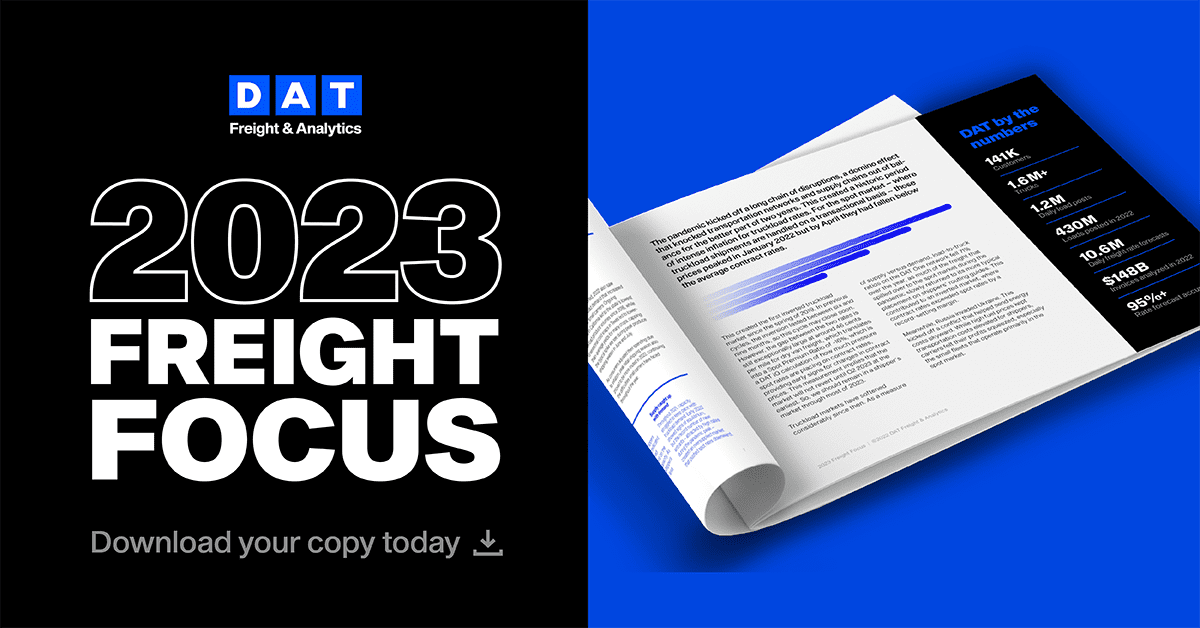Despite the economic headwinds facing many industries, there are strategic opportunities for transportation professionals in the new year’s trucking market. Taking advantage of them will require collaboration with your trusted partners, and those relationships will prove critical in 2023.
Of course, there are the usual suspects when it comes to truck market disruptions – hurricanes, snowstorms, etc. – but we can add recession, labor shortages, inflation and international conflict to the list. So, while we expect traditional seasonal patterns to reestablish themselves in the coming year, these key variables could quickly change the truck market. In other words, the need for flexibility never goes away. Check out these trucking trends and upcoming regulations below.
Trends
Inflation: While the US economy appears to be heading into a recession, there is no clear consensus on either the degree or duration. Inflation remained stubbornly high at 8.2% year-over-year in September, dropping slightly in October.
Fuel costs: Diesel prices dropped in late summer but stayed above $5 per gallon throughout fall. Though diesel is cheaper than it was a year ago, it remains close to its pre-2022 record price set in 2008. Nearly all American goods travel via truck, and inflated diesel prices drive inflation upward.
Interest rates: The Federal Reserve raised interest rates in November. This was the sixth increase of the year and the fourth consecutive time the hike was 0.75% – a dramatic increase. This suggests that there will be a recession of some degree in 2023.
All three of the above truck market trends lead to lower consumer demand for goods, which in turn reduces transportation volumes across essentially all modes. Some of this is welcome news. For example, the number of ships waiting to unload off the coast of Los Angeles is now in single digits, down from over 100 in January. This is due not only to lower overall shipment levels, but also because shippers shifted to East Coast ports. The dampening of demand for truckload services has been evident for months. The truck market has been inverted (where average national spot rates are below contract rates) since April. Dry van spot rates have dropped over 30% since peaking in January while contract rates have only dropped about 5% since they peaked in April.
Regulations
Speed limiters for commercial trucks
A new bill would require all new commercial trucks with a gross weight of 26,001 pounds or more to be equipped with speed-limiting devices, which must be set to a maximum speed of 65 miles per hour and be used at all times while in operation. Existing trucks of that size would be grandfathered into this law. The United States is one of the only developed nations without this regulation.
Financial security for freight brokers
The FMCSA collected comments regarding new financial responsibility requirements associated with the MAP-21 bill, and any proposed changes could impact the levels of financial security required for all brokers and freight forwarders. Read full details here.
New safety fitness ratings for carriers
On January 30, the Federal Motor Carrier Safety Administration agency is expected to publish an advance notice of a newly proposed rule that would change how motor carriers are scored on safety.
“FMCSA is seeking information on how the agency might use data and resources more effectively to identify unfit motor carriers and to remove them from the nation’s roadways,” the report stated. “FMCSA would seek public comment about the use of available safety data, including inspection data, in determining carrier fitness to operate.”
The administration will also take comments on the potential changes to its current three-tier safety fitness rating structure of satisfactory, conditional, and unsatisfactory.
Want to hear industry pros discuss trends like these? Watch below to hear DAT’s experts break it down.
Where can you find insights like this?
DAT iQ – The most accurate truckload analytics in the industry, DAT iQ provides deep insights to take the guesswork out of transportation. DAT iQ roots users in a foundation of deep industry knowledge, allowing them to make decisions with confidence.
RateView – This is where the best of the best tackle the challenge of pricing. RateView lets professionals see, compare, and contrast rates from across the country so they know they own pricing models are competitive. Perhaps even more valuable, they have access to DAT’s powerful predictive analytics that forecast what rates may be in the future so they’re always a step ahead of the competition. With RateView, users compare spot and contract rates, get the most current market insights, see the seasonal trends happening in real-time, and much, much more. Over 7 million daily predictions and 13-month pricing histories inform the nation’s best and brightest to profitability and success.
DAT’s Market Updates Blog – We don’t want to put a price gate on success, though. Our in-house experts comb through these datasets and write in-depth articles discussing the implications of market conditions.
DAT’s Weekly Trendlines – Similar to our Market Updates blog, our analysts give you a free macro look at the industry each week. On that page, you’ll find get a snapshot of critical industry indicators like fuel prices, spot loads posted, spot load trucks available, national averages for van, flatbed, and reefer spot rates, a weekly brief that gives an expert’s take on what we’re seeing, and another collection of resources at the bottom where you can learn more about those trends.
DAT iQ Live – Every week on YouTube and LinkedIn, these same experts host a live discussion breaking down the industry. Like our weekly trendlines, they’ll discuss what the industry is up against, the factors contributing to the market conditions, and solutions professionals can pursue to capitalize on opportunities.


